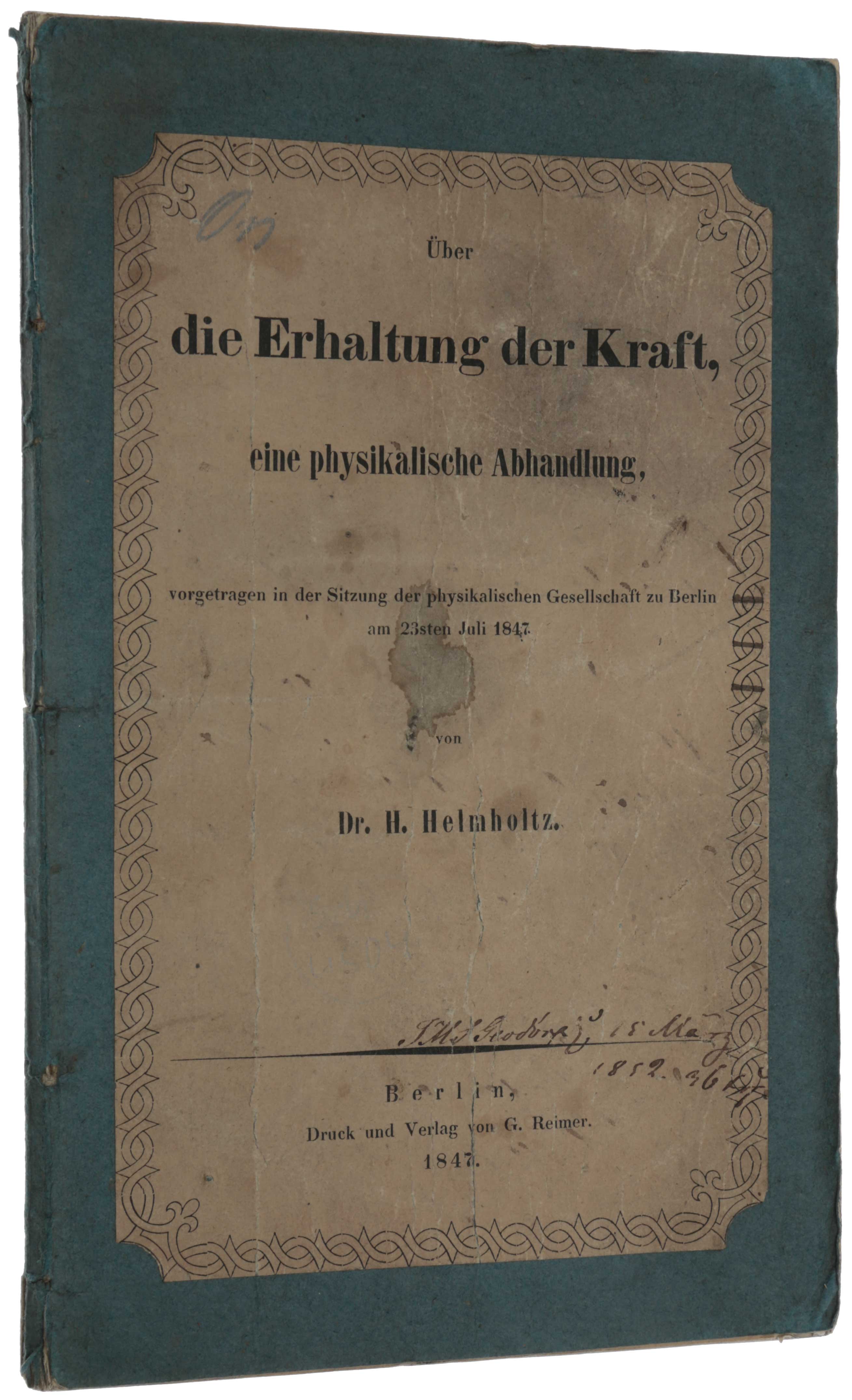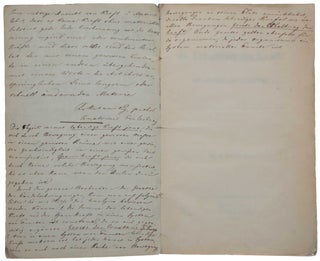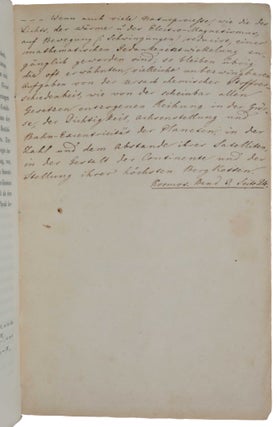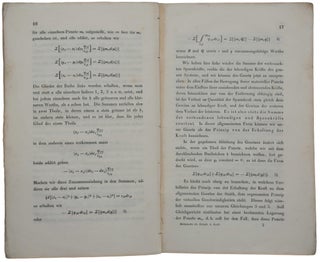Über die Erhaltung der Kraft, eine physikalische Abhandlung, vorgetragen in der Sitzung der physikalischen Gesellschaft zu Berlin am 23sten Juli 1847.
Berlin: Georg Reimer, 1847. First edition, rare, of “the first comprehensive statement of the first law of thermodynamics: that all modes of energy, heat, light, electricity, and all chemical phenomena, are capable of transformation from one to the other but are indestructible and cannot be created” (PMM). “On the basis of this short paper, written when he was only twenty-six, Helmholtz is ranked as one of the founders, along with Joule and Mayer, of the principle of conservation of energy. The paper sets forth the philosophical and physical basis of the energy conservation principle: Helmholtz maintained that the scientific world view was based on two abstractions, matter and force, and since the only possible relationship that can exist among the ultimate particles of matter is a spatial one, then ultimate forces must be moving forces radically directed. This can be inferred from the impossibility of producing work continually from nothing. Helmholtz analyzed different forms of energy and different types of force and motion, grouping them into two categories, active (kinetic) and tension (potential). He also gave mathematical expression to the energy of motion, providing an experimental measure for research on all forces, including those of muscle physiology and chemistry” (Norman). “Intended expressly for ‘physicists,’ Helmholtz’s 1847 paper must be counted as one of the most impressive first publications in the history of physics. Helmholtz had the highest regard for the principle he developed there, speaking of it fifteen years later, for example, as the most important scientific advance of the century because it encompassed all laws of physics and chemistry. On the occasion of Helmholtz’s hundredth birthday, in 1921, his former student Wilhelm Wien could write that the significance of the principle was still growing” (Jungnickel & McCormach, p. 161). ABPC/RBH record 10 copies in the last fifty years, the most recent being a copy in a modern binding, without wrappers, sold at PBA Galleries in 2015, which made $27,000. “Benjamin Thompson, Count Rumford, the American-born scientist largely responsible for the foundation of the Royal Institution and the founder of the Royal Society’s Rumford Medal, was the first to challenge successfully the accepted theory that heat was the manifestation of an imponderable fluid called ‘caloric’. He declared, and gave experimental proof before the Royal Society in I798, that heat was a mode of motion. Rumford was, in fact, conspicuous in his day for what was considered his old-fashioned theory of heat. He harked back to the seventeenth-century views of Bacon, Locke and Newton in opposition to the fashionable modern theory of caloric, which, indeed, worked very well, especially in chemistry. “Sadi Carnot, in 1824, approached very close to the principle of the conservation of energy and his brother found among his papers an almost explicit statement of it, although Carnot had actually used the caloric theory in his researches. J. R. Mayer, in Liebig’s Annalen, 1842, demonstrated its application in physiological processes, but his paper made little impression until it was reprinted as a polemic in 1867. J. P. Joule made a manuscript translation of Mayer’s thesis for his own use, and, in a series of papers in the Philosophical Magazine, 1840-3, provided experimental proof of the mechanical equivalent of heat for physical phenomena” (PMM). Helmholtz worked out the principle of the conservation of force soon after completing his education in Berlin. While a student at the gymnasium in nearby Potsdam where his father taught classical languages, he had decided that he wanted to study physics. Since his father could afford this plan only if he studied physics within a medical education, in 1838 he entered the Friedrich-Wilhelms-Institut in Berlin. This state medical-surgical institution trained army physicians by providing them with a free medical education at Berlin University. Helmholtz wrote his dissertation at the university on the physiology of nerves under Johannes Muller and received his M.D. in 1842. In 1843 he published his first independent investigation in Muller's Archiv and that year took up his duties as army surgeon at Potsdam. There at the army post, he set up a small physical-physiological laboratory. He also kept up the scientific associations he had formed at Berlin University. In Berlin, Helmholtz was drawn into the circle of Muller’s students, befriending especially du Bois-Reymond and Brucke, who were united in their desire to eliminate from physiology the concept of life force, in their eyes an unscientific concept left over from nature philosophy. They wanted to see how far physics and chemistry could go in explaining life processes, which brought them into contact with physicists in Berlin, above all with Magnus. Because a state examination for physicians required Helmholtz to spend a half year in Berlin, in the winter of 1845-46 he worked regularly in Magnus's private laboratory. Du Bois-Reymond, who had participated in Magnus's physical colloquium, introduced Helmholtz to the newly formed Berlin Physical Society, which was soon to provide the first audience for his work on the conservation of force. He regularly attended the meetings of the society, and for the first volume, as for later volumes, of the Fortschritte der Physik, he reported on researches in physiological heat. “Helmholtz’s work on the conservation of force required a sound knowledge of mathematical physics, which he had acquired in his early years in Berlin. He had read extensively in the literature; in 1841, for example, after his first medical examinations were over, he was left with some free time, which he devoted to the study of mathematics and the advanced parts of mechanics. On his own, or with a friend, he studied the writings of Laplace, Biot, Poisson, Jacobi, and others. He attended no lectures in mathematical physics or in mathematics at Berlin; in these subjects he was largely self-taught. “By 1847, the year of his publication on the conservation of force, Helmholtz had already been ‘convinced for years,’ according to his friend and biographer Leo Koenigsberger, of the validity of a principle of this sort. He recognized that the question of whether living beings are to be understood by the action of a life force or by the action of the same forces that occur in lifeless nature is closely connected with a conservation principle for forces. He also recognized that to establish to the satisfaction of the scientific world a mathematically formulated conservation principle would require a series of investigations in various parts of physiology and physics. In 1845, for example, he published a paper in which he tested his physical understanding of a difficult physiological problem, namely, the chemical changes occurring in muscles owing to their mechanical action. Studying frogs with the help of a self-constructed electrical machine and a Leyden jar, he succeeded in demonstrating these changes and even obtained quantitative results. For even more exact results, he had to determine the relations between the action of muscles and the heat developed, which required new investigations. In the Fortschritte der Physik for 1845, which appeared in 1847, Helmholtz published a report on theories of physiological heat which he later acknowledged as belonging to his work on the conservation of force. “In February 1847, while still an army surgeon at Potsdam, Helmholtz wrote to du Bois-Reymond that in his latest reworking of an essay on the conservation of force, he had ‘thrown overboard everything that smells of philosophy,’ and he was anxious for du Bois-Reymond’s opinion of how it would go down with the physicists. That summer, Helmholtz read the completed work to the Berlin Physical Society, where it aroused enthusiasm, at least among some members. Helmholtz immediately sent it to Magnus asking him to forward it to Poggendorff for publication in the Annalen der Physik. Poggendorff appreciated the importance of the problem Helmholtz addressed and his handling of it, but he rejected the paper. It was too long to be fitted into the Annalen that year, Poggendorff said; but his main reason for rejecting it had to do with its nature: ‘The Annalen is necessarily dependent above all on experimental investigations,’ and Poggendorff would have to sacrifice some of these if he wished to ‘open the door to theoretical’ investigations like Helmholtz’s. “Through Magnus, Poggendorff recommended that Helmholtz have the work published privately. Helmholtz accordingly approached the Berlin publisher G. A. Reimer, to whom he explained that the work would not be expensive to produce: it was not long, required no copper plates, and had ‘relatively little mathematical type.’ The subject of the work was the generalization of a ‘fundamental law of mechanics,’ he explained further; he had reached his result by ‘extensive and exact’ work on ‘all branches of physics.’ Privately, he had learned of considerable interest in this work; he submitted to Reimer letters about it from Magnus, du Bois-Reymond, and Brucke, and he added that Muller could testify to his scientific ability. He realized that he could expect no money from its publication and only wanted fifteen free reprints. Reimer agreed to publish it and, to Helmholtz's surprise, paid him an honorarium. “From his study of the older mechanical treatises, Helmholtz learned the strong proof of the impossibility of perpetual motion. In his physiological studies, he questioned the possibility of perpetual motion outside mechanics, in heat, electricity, magnetism, light, and chemistry. His solution to the problem of determining precisely which relations must obtain between natural forces so that perpetual motion is impossible in general was the principle of the conservation of force. “Helmholtz based the principle on either of two maxims, which he proved equivalent. One is that from any combination of bodies, it is impossible continuously to produce moving force from nothing. The other is that all actions can be reduced to attractive and repulsive forces that depend solely on the distance between material points. The problem of science is, he said, to reduce all phenomena to unchanging causes, which are the unchanging forces between material points. As the ‘solvability of this problem is also the condition of the complete comprehensibility of nature,’ the problem of ‘theoretical natural science’ will be solved once this ‘reduction of natural phenomena to simple forces is completed and at the same time is proven to be the only possible reduction the phenomena allow.’ “The impossibility of unlimited moving force had been adopted as a maxim by Carnot and Clapeyron in their theoretical studies of heat, and Helmholtz made it his ‘purpose’ to extend it throughout ‘all branches of physics.’ The maxim is equivalent in mechanics to the principle of the conservation of ‘living force’ (or ‘vis viva’ or ‘kinetic energy’). Helmholtz proved that this principle requires that the forces be ‘central,’ that is, that they depend on the distance between material points and act along their joining line. He showed that the increase in the living force of a material point due to the action of a central force equals the sum of the ‘tension forces’ due to the change in the position of the point … Helmholtz concluded that the sum of the living forces and the tension forces is constant. This he called the ‘principle of the conservation of force.’ “Helmholtz applied this conservation principle to some mechanical theorems and then to the other parts of physics, which provided the truly interesting cases and the testing ground. A supporter of the mechanical theory of heat, he accounted for the apparent loss of living force of two bodies after undergoing an inelastic collision by the conversion of their living force into tension forces and heat. He was especially interested in applying the conservation principle to electricity, magnetism, and electrodynamics, subjects which offered manifold instances of force conversions. For example, he deduced the electromotive force of two metals in a cell by equating through the conservation principle the heat developed chemically in the cell to that developed electrically in the wire. In this example, in which heat serves as a measure of the forces, he brought together nearly all of the known quantitative laws of electric current: Ohm’s law, Lenz’s law for the heat developed in a length of wire, James Prescott Joule’s more general law for the heat developed in any circuit, the laws of complex circuits that Kirchhoff was then working out, and Faraday’s law of electrolysis. In another example, Helmholtz applied the conservation principle to connect the chemical, thermal, and mechanical processes entering the electrodynamic interaction of a fixed, closed current produced by a cell and a nearby magnet free to move in space. Here he made use of Neumann's potential for a closed current; with it and by simple mathematical steps, he derived a number of Neumann's cases of induced currents. In addition to recovering these known results, he derived a new result, showing the power of the conservation principle to link the parts of physics; by equating his and Neumann's formulas for the current in the wire, he showed that Neumann's empirical, undetermined constant from electrical theory e is the reciprocal of the mechanical equivalent of heat. In these examples, to apply the conservation principle, Helmholtz did not need a detailed knowledge of the mathematical form of the acting central forces, the existence of which the principle presumably guaranteed. The forces were often still unknown or problematic; for example, with regard to Weber’s fundamental law of electric action, which relates the force between electric masses to their relative motion, Helmholtz observed that no hypothesis had yet been established that could reduce inductive phenomena to ‘constant central forces.’ “Throughout his paper on the conservation of force, Helmholtz referred not only to theoretically founded laws but also to a good deal of experimental work on the establishment of laws by Riess, Poggendorff, Weber, and others. He pointed to his predictions as waiting to be tested. His purpose was not just theoretical; it was also to show the experimental significance of the new results he obtained by joining established laws by means of the conservation principle. He concluded his study with the observation that the ‘complete confirmation’ of the conservation principle was a main task of physics in the immediate future. “But as Poggendorff noted when he rejected it, Helmholtz’s paper did not report original experiments. For that reason it could seem overly speculative to experimental physicists, who were not at first persuaded of the conservation principle. When physicists did admit it into their literature, they did so with caution. ‘I have received the first part of the physics annual report,’ Helmholtz wrote to du Bois-Reymond about the Fortschritte der Physik for 1847, ‘and was not a little surprised to see my Erhaltung der Kraft placed by Karsten with physiological heat phenomena, although I had submitted it written up separately.’ Later Helmholtz reported for the Fortschritte on related papers by Robert Mayer and others, and he took the occasion to place his own paper in the physical context he had originally intended for it. “The task of persuading physicists of the conservation principle was not entirely Helmholtz’s in any case. With marked differences of approach and purpose, Mayer and several other natural scientists in the 1840s worked on problems arising from a widely shared belief in the unity of nature and the indestructibility and transformability of forces. As one of several statements of the measure of the relations between the forces of nature, Helmholtz’s came to be regarded as the mathematical foundation for the principle of the conservation of ‘energy.’ Within a few years, Helmholtz acknowledged that his terms ‘living force’ and ‘tension force’ were synonymous with W. J. M. Rankine's ‘actual [kinetic] energy’ and ‘potential energy’ and that Rankine’s term ‘conservation of energy’ was preferable to his own ‘conservation of force.’ “With Helmholtz's principle, the several, often qualitative, assertions of the conservation and convertibility of forces received precise expression. The many newly discovered relations between the forces of nature did not require any major change in the understanding of these forces, which derived from the example of Newton's gravitational force; this was one of the more remarkable implications of Helmholtz's paper. Physicists who accepted Helmholtz’s reasoning were concerned on the most fundamental level, with just those things mechanics was concerned with: material points, constant central forces, relative positions and motions, the laws of motion and associated principles such as the principle of virtual velocities, and the principle of the conservation of force, or energy, which Helmholtz saw as an extension of the principle of the conservation of living force in mechanics. Helmholtz claimed that his paper of 1847 was independent of metaphysical considerations; later, in 1881, when he included it in his collected papers, he acknowledged that he had been indebted to Kant’s philosophy in his view that the law of causality was essential for understanding nature and that central forces were ultimate causes. He derived his conservation principle within a certain picture of the physical world, one governed by mechanical concepts and laws. It was one of the great conceptions of nature underlying much nineteenth-century physical research, and in Germany Helmholtz gave it a complete definition; over the course of his long career, he developed its implications throughout physics” (Jungnickel & McCormach, pp. 156-61). Dibner 159. Garrison-Morton (online) 611. Horblit 48. Norman 1039. Printing and the Mind of Man 323. Jungnickel & McCormach, Intellectual Mastery of Nature, Vol. 1, The Torch of Mathematics 1800-1870 (1986).
8vo (220 x 135 mm), pp. [iv], 72. Later 19th century plain blue wrappers with original front printed wrapper cut down and mounted on upper cover (wrappers a bit soiled). Three pages of early manuscript notes in an unidentified hand bound in at end discussing the concept of ‘Kraft’ in various areas of physics and referring to Humboldt’s Cosmos.
Item #4842
Price: $45,000.00








